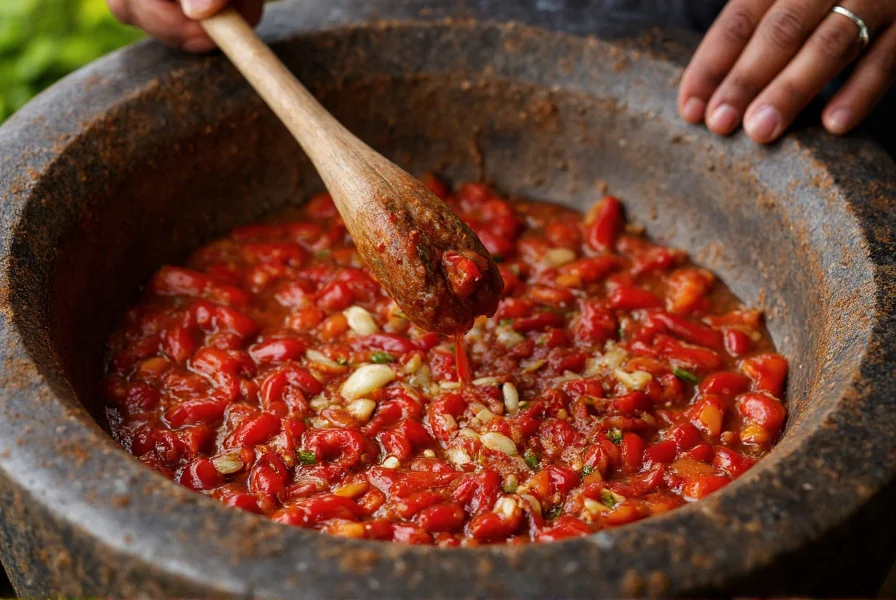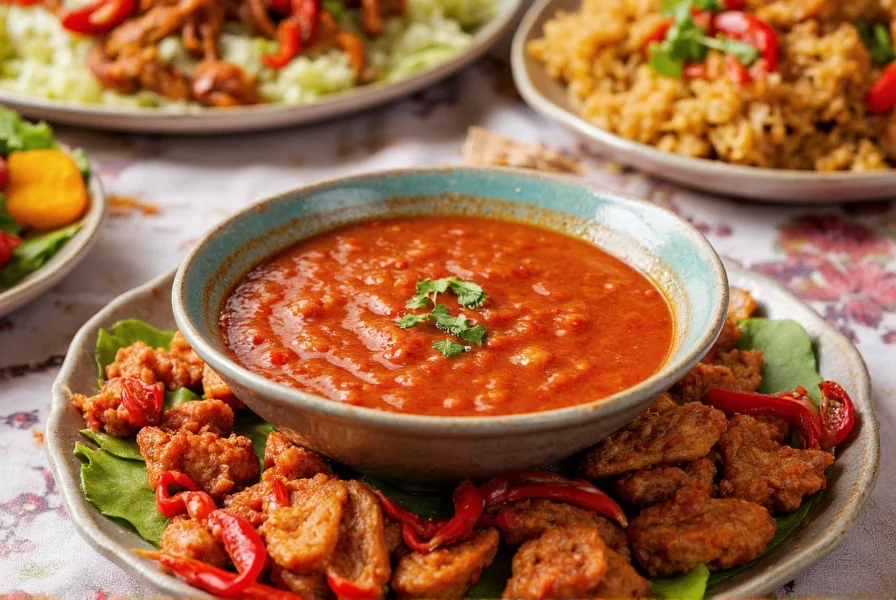Sambal isn't just heat—it's a complex flavor foundation that elevates Southeast Asian cooking. Understanding its nuances helps home cooks and food enthusiasts incorporate authentic flavors into their culinary repertoire. Unlike generic hot sauces, traditional sambal balances fiery chilies with umami, sweetness, and acidity to create multidimensional flavor profiles.
The Cultural Roots of Sambal
Originating in the Indonesian archipelago, sambal has been a culinary staple for centuries. The word "sambal" comes from Javanese, referring to the pounding technique used to prepare the sauce. Every Indonesian household traditionally maintains its own sambal recipe, often passed down through generations. The sauce's importance is reflected in the Indonesian saying, "No meal is complete without sambal." While Indonesia remains the epicenter of sambal culture, variations have spread throughout Malaysia, Singapore, Brunei, and Sri Lanka, each adapting the basic concept to local ingredients and preferences.
Core Ingredients and Regional Variations
The foundation of most sambals consists of fresh chilies, salt, and a binding agent like vinegar or lime juice. However, regional differences create remarkable diversity:
| Regional Variation | Key Ingredients | Distinctive Characteristics |
|---|---|---|
| Sambal Oelek (Indonesia) | Red chilies, salt, vinegar | Pure chili flavor, minimal additional ingredients, versatile base |
| Sambal Terasi (Indonesia) | Chilies, fermented shrimp paste, lime | Strong umami depth, pungent aroma, essential for nasi goreng |
| Sambal Belacan (Malaysia) | Chilies, toasted shrimp paste, tamarind | Sweet-sour profile, common with Malaysian dishes |
| Sambal Matah (Bali) | Shallots, lemongrass, kaffir lime, raw chilies | Raw preparation, herbal notes, less cooked flavor |
Traditional Indonesian sambal recipes often incorporate local chili varieties like bird's eye chilies (cabe rawit) for intense heat or larger red chilies (cabe merah) for milder, fruitier flavor. The preparation method—whether pounded in a mortar and pestle (cobek) or blended—affects texture and flavor integration.

Authentic Sambal Preparation Techniques
Creating authentic sambal requires understanding traditional preparation methods. The mortar and pestle technique (cobek and ulekan) releases essential oils differently than mechanical blending, creating a more complex flavor profile. For cooked sambals, the "tumis" technique—slowly frying the paste in oil—develops deeper flavors through the Maillard reaction.
When making homemade sambal chili sauce, ingredient proportions vary based on regional preferences and personal tolerance. A basic sambal oelek ratio might be:
- 100g red chilies (stemmed and washed)
- 1 teaspoon salt
- 1 tablespoon vinegar or lime juice
- 1-2 cloves garlic (optional)
The chilies are traditionally pounded first with salt to break down cell walls, then other ingredients are gradually incorporated. For sambal terasi, the shrimp paste should be toasted first to mellow its pungency.
Practical Culinary Applications
Understanding how to use sambal in cooking separates authentic application from superficial spicing. Southeast Asian chefs employ sambal in three primary ways:
- As a base—added early in cooking to infuse dishes with foundational flavor (common in curries and stews)
- As a seasoning—stirred in during cooking to adjust heat and flavor balance
- As a condiment—served tableside to customize heat levels to individual preference
Different sambal types suit specific applications. Sambal oelek works well as a cooking base due to its clean chili flavor, while sambal terasi shines as both cooking ingredient and finishing condiment thanks to its complex umami profile. When substituting store-bought for homemade sambal, adjust quantities as commercial versions often contain preservatives and stabilizers that affect flavor intensity.

Storage and Shelf Life Considerations
Proper storage maintains sambal's flavor integrity. Freshly made sambal keeps for 3-4 days refrigerated in airtight containers. For longer preservation:
- Freeze in ice cube trays then transfer to freezer bags (keeps 3-6 months)
- Add extra vinegar (5-10%) to extend refrigerated shelf life to 2-3 weeks
- Store under thin layer of cooking oil to create preservation barrier
Commercial sambal chili sauce typically contains preservatives allowing shelf stability, but homemade versions lack these additives. Always check for signs of spoilage like mold, off-odors, or separation that doesn't reincorporate when stirred.
Substitutes and Adaptations
When authentic sambal isn't available, suitable alternatives depend on the intended use:
- For cooking base: Thai chili paste or gochujang (adjusting for sweetness)
- For finishing condiment: Sriracha mixed with fish sauce and lime juice
- Vegan adaptation: Replace shrimp paste with toasted soybeans or miso
Understanding the role of sambal in a specific dish helps determine the best substitute. For traditional Indonesian recipes, substitutions may alter authenticity but can still produce delicious results.
Frequently Asked Questions
What's the difference between sambal and sriracha?
Sambal represents a diverse category of Southeast Asian chili sauces with hundreds of regional variations, typically featuring fresh chilies with minimal processing. Sriracha is a specific Vietnamese-American style sauce made from ripened red jalapeños, garlic, vinegar, sugar, and salt, then pureed and aged. Traditional sambal often contains shrimp paste for umami depth and varies significantly by region, while sriracha maintains a consistent sweet-garlic profile.
How spicy is traditional sambal chili sauce?
Spice levels vary dramatically by type and region. Basic sambal oelek ranges from 10,000-50,000 Scoville units (similar to cayenne pepper), while sambal using bird's eye chilies can exceed 100,000 units. Indonesian sambals tend to be hotter than Malaysian versions. Heat can be controlled by removing chili seeds and membranes, using milder chili varieties, or increasing secondary ingredients like tomatoes or shallots.
Can I make sambal without shrimp paste?
Yes, many sambal varieties don't include shrimp paste (terasi). Sambal oelek, sambal matah, and tomato-based sambals are naturally shrimp paste-free. For vegan adaptations of sambal terasi, substitute toasted soybeans, miso paste, or additional umami ingredients like mushrooms. The shrimp paste primarily contributes depth rather than fishiness when properly toasted, so alternatives should focus on replicating that savory complexity.
What dishes pair best with sambal chili sauce?
Sambal complements grilled meats (especially chicken and fish), fried eggs, rice dishes (nasi goreng), and vegetable stir-fries. Specific pairings include sambal matah with grilled fish, sambal terasi with fried rice, and sambal dabu-dabu with seafood. It also enhances Western dishes like sandwiches, roasted vegetables, and even Bloody Mary cocktails when used thoughtfully.
How can I reduce the heat of sambal without losing flavor?
To moderate sambal's heat while preserving flavor, add acidic components like lime juice or tamarind, which balance rather than mask heat. Sweet elements such as palm sugar or ripe tomatoes also help counterbalance spiciness. For immediate relief, mix with coconut milk or yogurt. When preparing fresh sambal, remove chili seeds and white membranes where capsaicin concentrates, or blend milder chilies with hotter varieties.











 浙公网安备
33010002000092号
浙公网安备
33010002000092号 浙B2-20120091-4
浙B2-20120091-4